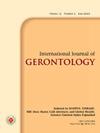Screening Test for At-Risk Drinking in the Elderly: Abbreviated Version of the Alcohol Use Disorders Identification Test for the Elderly Population
IF 0.3
4区 医学
Q4 GERIATRICS & GERONTOLOGY
引用次数: 1
Abstract
Background: In this study, we developed the Screening Test for At-risk Drinking in the Elderly (STAD-E), a new abbreviated version of the Alcohol Use Disorders Identification Test (AUDIT) intended for use in the elderly populations. This test comprises three questions that reflect the structure of the AUDIT 10 questionnaire and the characteristics of the Korean population and was developed using nationally representative data from the Korea National Health and Nutrition Examination Survey (KNHANES). Methods: We performed exploratory factor analysis for each question from the AUDIT questionnaire that was responded by elderly (≥ 65 years) participants of KNHANES IV-V to derive our abbreviated test based on the structure of each AUDIT item. For validation, we analyzed the sensitivity, specificity, and area under the receiver operating characteristic curve (AUROC) of the new abbreviated test using KNHANES VI datasets (excepting KNHANES VI-2). Results: We selected question (Q) 1, Q3, and Q7 on the three-factor structure for the elderly population. The cut-off values of STAD-E were 4 for elderly males and 3 for elderly females. During the validation test, STAD-E yielded significantly greater AUROC values than AUDIT-QF and similar values to AUDIT-C. Conclusions: Unlike previous abbreviated tests, STAD-E reflects the item structure of AUDIT and the alcohol consumption patterns in an elderly population. Therefore, it can be used as a simple and reliable screening test for at-risk drinking in clinical settings.背景:在本研究中,我们开发了老年人高危饮酒筛查试验(STAD-E),这是酒精使用障碍识别试验(AUDIT)的新缩写版本,旨在用于老年人人群。该测试包括三个问题,反映了审计10问卷的结构和韩国人口的特征,并利用韩国国家健康和营养检查调查(KNHANES)的全国代表性数据开发。方法:我们对KNHANES IV-V老年人(≥65岁)回答的审计问卷中的每个问题进行探索性因素分析,根据每个审计项目的结构推导出我们的简化检验。为了验证,我们使用KNHANES VI数据集(KNHANES VI-2除外)分析了新的简化试验的敏感性、特异性和受试者工作特征曲线下面积(AUROC)。结果:我们选取了老年人群的三因素结构问题(q1)、Q3和Q7。老年男性STAD-E截断值为4,老年女性STAD-E截断值为3。在验证测试期间,STAD-E产生的AUROC值明显大于AUDIT-QF,与AUDIT-C产生的AUROC值相似。结论:与以往的简化测试不同,STAD-E反映了审计项目结构和老年人群的酒精消费模式。因此,在临床环境中,它可以作为一种简单可靠的高危饮酒筛查试验。
本文章由计算机程序翻译,如有差异,请以英文原文为准。
求助全文
约1分钟内获得全文
求助全文
来源期刊
CiteScore
0.60
自引率
0.00%
发文量
0
审稿时长
6-12 weeks
期刊介绍:
The Journal aims to publish original research and review papers on all fields of geriatrics and gerontology, including those dealing with critical care and emergency medicine.
The IJGE aims to explore and clarify the medical science and philosophy in all fields of geriatrics and gerontology, including those in the emergency and critical care medicine. The IJGE is determined not only to be a professional journal in gerontology, but also a leading source of information for the developing field of geriatric emergency and critical care medicine. It is a pioneer in Asia.
Topics in the IJGE cover the advancement of diagnosis and management in urgent, serious and chronic intractable diseases in later life, preventive medicine, long-term care of disability, ethical issues in the diseased elderly and biochemistry, cell biology, endocrinology, molecular biology, pharmacology, physiology and protein chemistry involving diseases associated with age. We did not limit the territory to only critical or emergency condition inasmuch as chronic diseases are frequently brought about by inappropriate management of acute problems.

 求助内容:
求助内容: 应助结果提醒方式:
应助结果提醒方式:


